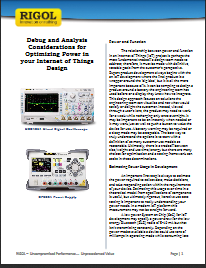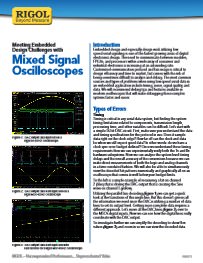CALL US ON+44 (0) 161 871 7450
Internet Of Things. Challenges Engineers Face and Application Notes For Solutions

What is IoT? In basic terms it is the concept of connecting any device with an on and off switch to the Internet (and/or to each other).The phrase was originally coined back in 1999 by Kevin Ashton and later was discussed more in depth in 2009. Technology has changed drastically since 1999 including the challenges engineers face in regards to developing and testing the latest technology and the exciting ideas tomorrow.
Instruments 4 Engineers are proud to be authorized distributors for Rigol whom have developed a reliable and cost effective range of equipment for various IOT applications. Whether seeking to optimize power consumption, deploy sensor arrays, debug serial communications, or efficiently integrate wireless technologies RIGOL has a solution to speed up your IoT development. Rigol 's portfolio of time and frequency domain test solutions provide Engineers with advanced analysis capabilities . Please read below to find out more information about Rigol product solutions distributed by Instruments 4 Engineers Ltd and Application notes
Iot Power Analysis
Debug & Analysis of Power Requirements:
Deciding the balance between function and battery life is one of the most important steps in IoT Development. Some of the questions engineers often struggle with questions like should I use a larger battery or should we reduce radio communication?
Learn our approach to understanding your power usage and avoid design requirement changes that can derail your IoT product. You can avoid derailing your Internet of Things product by understanding power usage and avoiding design changes.
Increase your knowlege of how your IoT project will consume power and shorten battery life start with a test regiment of baseline power analysis. Engineers should consider the nominal power usage, the boot up energy requirement, and the power used by peripherals that will be needed. Engineers can reduce the risk of design changes late in the project by iteratively testing power usage while updating the software and hardware configurations on their platform. In the video below Rigol demonstrate IoT Power Managerment.
More useful information can be found in the application notes below for Debug Analysis and Embedded Design Application Notes by Rigol including a video below. Instruments used for the application notes below include Rigol DP800 Series Power Supplies, Rigol DS/MSO 4000 Series Oscilloscopes and R1002C current probe.
Debug & Analysis of IoT Power Requirements Application Note:
Real-world measurements and techniques for understanding how IoT platforms draw and utilize power and what it means to the overall product design
Rigol's Embedded Design Guide:
Evaluate errors in low speed serial embedded signals caused by timing, noise, signal quality, and data issues with an advanced oscilloscope
_______________________________________________________________________________________________________________________
Radio Internet of Things Power Usage 2.4GHz:
One of the important power uses of an IoT device is it’s RF output power, but how much power does it take to run the entire RF peripheral and how do you optimize it? Evaluate RF power throughout development and characterize power use in different modes.
Whatever your IoT passion, your product likely connects wirelessly to a network, sensors, or both. In the 2.4 GHz band Bluetooth, Wi-Fi, Zigbee many other wireless protocols compete for data bandwidth. Evaluating the battery implications of exchanging RF data is an important element in understanding the overall operation of any IoT device. Using a IoT development platform we compare methods for measuring the power consumed by different radio operating modes. Instruments used in the below video and application notes are Rigol DSA800 Series Spectrum Analyzers,Rigol DS/MSO4000 Oscilloscopes, Rigol DP800 Power Supplies, and R1002C current probe.
![]()
The Rigol DSA800 series spectrum analys
ers maybe suitable for some parts of Zigbee applications. Although demodulation of Zigbee signals are not possible,frequency analysis is possible and monitoring the 3rd harmonic of 2.4 GHz signals (excludeds Rigol DSA815).
Rigol DSA 800 Series Spectrum Analysers:
Rigol DSA875
Rigol DSA875-TG
Debug & Analysis of IoT Power Requirements Application Note:
Real-world measurements and techniques for understanding how IoT platforms draw and utilize power and what it means to the overall product design.

_____________________________________________________________________________________________________________________
Wireless Sensor Characterization
Characterize ASK/FSK Sensor Communication:
Many IoT sensors connect wirelessly to the main application platform over one of many ASK or FSK protocols from 800 or 900 MHz bands up through 2.4 GHz. Characterizing how these sensors perform in real world environments is critical to understanding how best to implement network communication, range, and sensor deployment.
Even the simplest sensors and communication protocols need to be characterized before sending an the device to market. Characterize error budgets for timing, radio power, and modulation settings in a real environment before critical baseband data errors effect performance. Use a Spectrum Analyzer’s real time bandwidth to analyze the RF signal.


